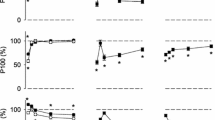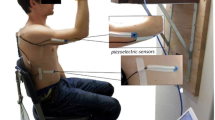Summary
Sixteen subjects, nine women and seven men, aged between 19 and 35 years, performed three series of isometric contractions of the flexor muscles of the forearm at 40% MVC. Each series consisted of four isometric contractions sustained until exhaustion, and separated from each other by an incomplete rest interval of 5 min. The position of the arm (either the lower or the upper position) was variable according to the series. Under these conditions, study of heart rate (HR), systolic blood pressure (SBP) and limit-time showed that:
-
1.
HR and SBP were not affected by the arm position even when fatigue was important.
-
2.
For a given load with a progressive appearance of fatigue, the limit-time in female subjects was higher.
-
3.
In both groups, in spite of the fatigue appearing after several isometric contractions performed in the upper position, movement of the arm to the lower position was sufficient to significantly increase the time-limit of another isometric contraction at 40% MVC without concomitant increase in cardiac work.
Similar content being viewed by others
References
Barnes WS (1980) The relationship between maximum isometric strength and intramuscular circulatory occlusion. Ergonomics 23: 351–357
Eugene M, Bertholon JF, Carles J, Vandewalle H, Teillac A (1981) Mise en évidence de la relation entre la rigidité artérielle et l'aptitude physique à l'exercice musculaire. J Physiol [Paris] 77: 65A
Freyschuss U (1970) Elicitation of heart rate and blood pressure increase on muscle contraction. J Appl Physiol 28: 756–761
Funderburk CF, Hipskind SG, Welton RC, Lind AR (1974) Development of and recovery from fatigue induced by static effort at various tensions. J Appl Physiol 37: 392–396
Goodwin GM, McCloskey DI, Mitchell JH (1972) Cardiovascular and respiratory responses to changes in central command during isometric exercise at constant muscle tension. J Physiol [Lond] 226: 173–190
Hulten B, Thorstensson A, Sjodin B, Karlsson J (1975) Relationship between isometric endurance and fibre types in human leg muscles. Acta Physiol Scand 93: 135–138
Humphreys PW, Lind AR (1963) The blood flow through active and inactive muscles of the forearm during sustained handgrip contractions. J Physiol [Lond] 166: 120–135
Kahn JF, Stouvenel O, Sanchez J, Monod H (1981) Réactions cardio-circulatoires à un travail statique réalisé dans deux positons. J Physiol [Paris] 77: 66A
Kahn JF, Stouvenel O, Monod H (1984) Réactions cardio-circulatoires à un travail statique réalisé dans deux positions chez l'homme et chez la femme. Travail Humain [in press]
Karlsson J, Funderburk C, Essen B, Lind AR (1975) Constituants of human muscle isometric fatigue. J Appl Physiol 38: 208–211
Lind AR (1970) Cardiovascular responses to static exercise. Circulation 41: 173–176
Lind AR, Petrofsky JS (1979) The amplitude of the surface EMG during fatiguing isometric contractions. Muscle Nerve 2: 157–264
Mitchell JH, Schibye B, Payne FC, Saltin B (1981) Response of arterial blood pressure to static exercise in relation to muscle mass, force development, and electromyographic activity. Circ Res [Supp 1] 48: 70–75
Monod H (1979) Un dispositif pour la mesure des forces musculaires chez l'homme. Travail Humain 43: 213–214
Petrofsky JS, Lind AR (1975) Aging, isometric strength and endurance, and cardiovascular responses to static effort. J Appl Physiol 38: 91–95
Petrofsky JS, Burse RL, Lind AR (1975) Comparison of physiological responses of women and men to isometric exercise. J Appl Physiol 38: 863–868
Rogowsky M, Van der Putten M, Heyters C, Degre S (1978) Analyse de la contrainte musculaire dynamique et statique chez l'homme et chez la femme au cours d'un travail à faible dépense énergétique. Travail Humain 41: 210–223
Schibye B, Mitchell JH, Payne FC, Saltin B (1981) Blood pressure and heart rate response to static exercise in relation to electromyographic activity and force development. Acta Physiol Scand 113: 61–66
Thorstensson A, Karlsson J (1976) Fatiguability and fibre composition of human skeletal muscle. Acta Physiol Scand 98: 318–322
Thorstensson A, Larsson L, Tesch P, Karlsson J (1977) Muscle strength and fibre composition in athletes and sedentary men. Med Sci Sports 9: 26–30
Author information
Authors and Affiliations
Rights and permissions
About this article
Cite this article
Kahn, J.F., Monod, H. A study of fatigue during repetitive static work performed in two different segmental positions. Europ. J. Appl. Physiol. 53, 169–174 (1984). https://doi.org/10.1007/BF00422582
Accepted:
Issue Date:
DOI: https://doi.org/10.1007/BF00422582




